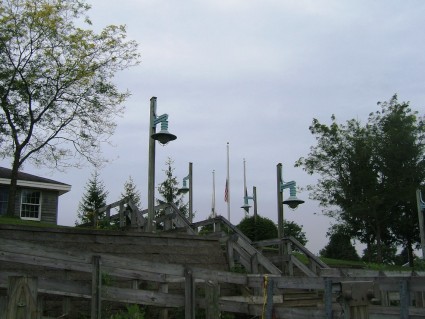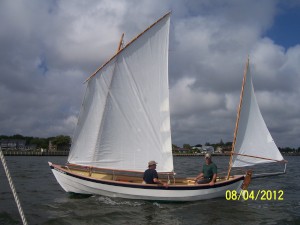
Sights and Sounds of Blood on the Sails
07 September 2013 | Ilion to Frankfort, NY
07 September 2013 | Sherburne, NY
05 August 2013 | Hamilton, NY
18 July 2013 | Brewerton, NY
14 July 2013 | Richfield Springs, NY
06 July 2013 | Hamilton, NY
14 June 2013 | Sherburne, NY
15 June 2012 | Seaford, NY
14 June 2012 | Seaford, NY
14 June 2012 | Seaford, NY
14 June 2012 | Seaford, NY
27 May 2012 | Seaford, NY
Mohawk River Sailing & trolling
07 September 2013 | Ilion to Frankfort, NY
Ginnie/cloudy/rainy 5mph wind

We entered the Mohawk River from the Ilion Marina. Our plan was to sail up to the town of Frankfort two miles away & then troll back. During our sail we started thinking about the history of this muddy edged river with its noisy trains running on the north side every 20 minutes or so. Such a relaxing sail we naturally started thinking about this area, what it's like now and what it must have been like, back in its heyday.
[The Mohawk River is a 149-mile-long (240 km) river in the state of New York. It is the largest tributary of the Hudson River. The Mohawk flows into the Hudson in the Capital District, a few miles north of the city of Albany. The river is named for the Mohawk Nation of the Iroquois Confederacy. It is a major waterway in north-central New York. The river and its supporting canal, the Erie Canal (a part of the New York State Canal System, called the New York State Barge Canal for much of the 20th century), connect the Hudson River and port of New York with the Great Lakes at Buffalo, New York. The lower part of the Mohawk River has five permanent dams, nine movable dams (seasonal), and five active hydropower plants.
The river has long been important to transportation and migration to the west as a passage through the Appalachian Mountains, between the Catskill Mountains and Allegheny Plateau to the south and the Adirondack Mountains to the north. The Mohawk Valley allowed easier passage than going over the mountains to the north or south of the valley. As a result, it was strategically important during the French and Indian War and the American Revolutionary War, and a number of important battles were fought here. The fertile Mohawk Valley also attracted early settlers.]
We sailed down the Mohawk for two hours with only a 5 knot wind and finally came across our turn towards the Frankfort Marina. Shortly after we spied the welcoming dock, and the marina's lovely "period" lighting. I just had to take a picture, it looked so cool and I started imagining pulling up to dock there, from a *packet boat, in the mid 1800's.
[In the early years of the Enlarged Erie Canal, both passenger boats (called "packets" or "packet boats") usually horse-drawn, and working boats (called "line boats" or "freighters"), drawn by either horses or mules, were common. Originally intended as a more comfortable alternative to the bone-jarring stagecoach, the packet boat fell out of favor as railroad travel improved, and basically disappeared by the latter half of the 1800s. On the current Erie (Barge) Canal, there being no towpath, line boats were replaced by tugboats ("tugs" or towing boats) with their attached barges, as well as motorized freighters. Today, the most common boats are recreational boats, although commercial traffic still exists, and has actually increased in recent years.
On the town of Frankfort: It was incorporated as a village in 1863 and is situated 9 1/2 miles east of Utica on the Mohawk River, the Barge canal, and the West Shore and the New York Central railroads. Interurban trolleys connect with Ilion, Little Falls and Utica. The principal industries are the manufacture of hoes and forks, chucks, castings and road building machinery. A considerable number of local workmen are employed in the factories of Ilion. The village is a shipping point for hay, straw and dairy products. Frankfort has a sewer system, electric lighting service and municipal water works. In 1912 Frankfort had 8 factories, with 473 operatives. The New York Central station here is North Frankfort and is connected with Frankfort, by bridge. There is a Barge canal retaining dam at Frankfort, to the west of which the canal generally follows a land line, westward to Rome, 25 miles. A Barge canal terminal dock is at Frankfort.]
Great sail and really interesting history!
[The Mohawk River is a 149-mile-long (240 km) river in the state of New York. It is the largest tributary of the Hudson River. The Mohawk flows into the Hudson in the Capital District, a few miles north of the city of Albany. The river is named for the Mohawk Nation of the Iroquois Confederacy. It is a major waterway in north-central New York. The river and its supporting canal, the Erie Canal (a part of the New York State Canal System, called the New York State Barge Canal for much of the 20th century), connect the Hudson River and port of New York with the Great Lakes at Buffalo, New York. The lower part of the Mohawk River has five permanent dams, nine movable dams (seasonal), and five active hydropower plants.
The river has long been important to transportation and migration to the west as a passage through the Appalachian Mountains, between the Catskill Mountains and Allegheny Plateau to the south and the Adirondack Mountains to the north. The Mohawk Valley allowed easier passage than going over the mountains to the north or south of the valley. As a result, it was strategically important during the French and Indian War and the American Revolutionary War, and a number of important battles were fought here. The fertile Mohawk Valley also attracted early settlers.]
We sailed down the Mohawk for two hours with only a 5 knot wind and finally came across our turn towards the Frankfort Marina. Shortly after we spied the welcoming dock, and the marina's lovely "period" lighting. I just had to take a picture, it looked so cool and I started imagining pulling up to dock there, from a *packet boat, in the mid 1800's.
[In the early years of the Enlarged Erie Canal, both passenger boats (called "packets" or "packet boats") usually horse-drawn, and working boats (called "line boats" or "freighters"), drawn by either horses or mules, were common. Originally intended as a more comfortable alternative to the bone-jarring stagecoach, the packet boat fell out of favor as railroad travel improved, and basically disappeared by the latter half of the 1800s. On the current Erie (Barge) Canal, there being no towpath, line boats were replaced by tugboats ("tugs" or towing boats) with their attached barges, as well as motorized freighters. Today, the most common boats are recreational boats, although commercial traffic still exists, and has actually increased in recent years.
On the town of Frankfort: It was incorporated as a village in 1863 and is situated 9 1/2 miles east of Utica on the Mohawk River, the Barge canal, and the West Shore and the New York Central railroads. Interurban trolleys connect with Ilion, Little Falls and Utica. The principal industries are the manufacture of hoes and forks, chucks, castings and road building machinery. A considerable number of local workmen are employed in the factories of Ilion. The village is a shipping point for hay, straw and dairy products. Frankfort has a sewer system, electric lighting service and municipal water works. In 1912 Frankfort had 8 factories, with 473 operatives. The New York Central station here is North Frankfort and is connected with Frankfort, by bridge. There is a Barge canal retaining dam at Frankfort, to the west of which the canal generally follows a land line, westward to Rome, 25 miles. A Barge canal terminal dock is at Frankfort.]
Great sail and really interesting history!
Comments
| Vessel Name: | Blood on the Sails |
| Vessel Make/Model: | Caledonia Yawl |
| Hailing Port: | Sherburne, NY |
| Crew: | Ginnie & Tom McDermott |
| About: | Husband & wife married in 1984, both born and raised on Long Island, NY. Moved up to Chenango County in rural Upstate NY in 1991 & raised 4 kids to adulthood. We have been fishing and boating companions, for more than 32 years. |
| Extra: | Tom's father built our 19 foot Caledonia Yawl back in 2012 for Tom, and we were able to finally bring her home to Sherburne, in June 2013! |
Gallery not available

Who: Ginnie & Tom McDermott
Port: Sherburne, NY